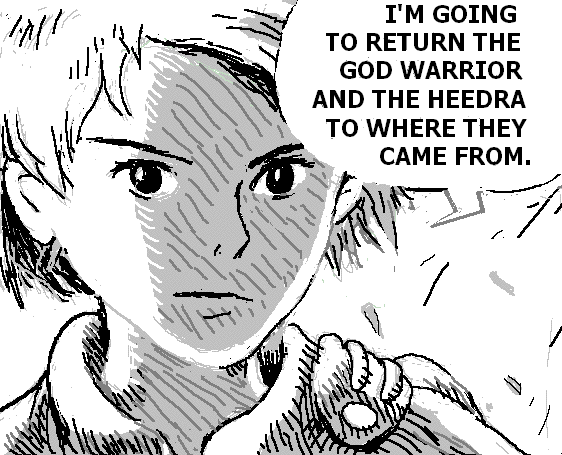View current page
...more recent posts
My review of the "Paradise/Paradox" exhibit at the College of New Rochelle, curated by Susan Canning, appears in the March issue of Sculpture magazine (print edition only). Here's a sample paragraph:
The three-dimensional work in the show is a curious mix of the hopeful, the cautionary, and the misguided. Recalling a 1950s model kit for high school biology students, Michael Joo’s Small Vitrine, 2000, presents a seated Buddha in clear cast plastic, with plastic bones and internal organs completely revealed. Conspicuously absent is the Holy One’s head, perhaps reflecting the ancient Zen wisdom that it’s the body part that gets us into the most trouble. And as if to prove Joo’s point, Colin Keefe shows us an overdetermined idea of Heaven, 2001, a seven-foot-tall model of a gyroscope-shaped space colony, which perpetuates, out among the stars, many of the foibles of 20th Century urban planning. On the inner surfaces of this partial Dyson sphere, living space in the form of hundreds of densely clustered high-rise buildings is segregated on two of the rings while the third is empty greenbelt. Another work of Keefe's, a drawing on a nearby wall, shows a series of barricaded enclaves separating city-dwellers from what appears to be unoccupied land. Yet if it‘s truly empty, why have the barricades?1 Finally, Jason Middlebrook mocks present-day notions of heaven on earth with an entropic, post-apocalyptic re-envisioning of Frank Gehry’s Guggenheim Bilbao design. The artist gets revenge on a pretentious architect by imagining the building partially collapsed, surrounded by weeds and rubble, and festooned with graffiti. (minor changes made in response to an editorial change to the original text)Below is the image of the Middlebrook piece that accompanies the review, Guggenheim Bilbao, Part II (2002, wood, paint, polystyrene, 34.25 x 52 x 39 in.). Behold Gehry's creation, as it deserves to be remembered:
1. No one seems to be sure what's going on in Keefe's work, exactly. On the reviews page on his website, Holland Cotter says it picks up the pieces of discarded utopian design, while Gary Michael Dault in the Toronto Globe says in so many words that it's winsomely dystopian. I'd say it's just plain dystopian.
UPDATE: The full text of this review is now online here.
A memorable book review on the (lamentably dormant) Strange Words website, titled "Charles Platt, Fun Interviewer" warns us about the Wired scribe's published conversations with famous science fiction writers, Dream Makers (Vols. I and II): that they are full of "creepy voyeurism," and that "Platt seems hell-bent on exposure, rather than the context of a writer's life." I just read my first Platt interview, with A.E. Van Vogt, and boy, they weren't kidding. Van Vogt comes off as a wacko, bore, and self-diagnosing Dianetics disciple, which he was, perhaps, but his fiction is really Out There and he deserves better treatment.
Van Vogt was one of editor John W. Campbell's "Big Three" writers, along with Arthur Clarke and Robert Heinlein. While the latter authors specialized in "hard" sf, Van Vogt was the visionary, specializing in tales of superhuman races and bizarre, alien logic systems. The basic plot of the movie Alien came from Van Vogt's story "The Black Destroyer," incorporated into the novel Voyage of the Space Beagle (after Darwin's HMS Beagle), a larger epic that, 16 years before Captain Kirk, told of a starship Seeking Out New Life and New Civilizations in the galaxies. The chapter where the catlike, tentacled horror is taken aboard the ship is here, and worth a read. Yes, it's pulpy, but it moves at a furious clip, introducing the players and political tensions on the vessel without letting up on the chills for a moment--even during a scene of explosive action. (It does everything but tell you what "Nexialism" is.) Van Vogt describes learning to write from intensive, obsessive study of a single how-to book, and the prescriptions for narrative economy and drive can really be felt in this passage.
Before Platt pulls out the big hatchet, he quotes Van Vogt talking about his own writing "system":
"In science fiction you have to have a little bit of a 'hang-up' in each sentence. Let's suppose, for example: The hero looks up toward the door." Van Vogt gestures toward the sunlit screen door of his living room, leading out onto the veranda. "He hears a sound over there. And something comes in. It looks like a man wearing a cloak. You don't quite know what's going on. Then, you realize this is not a human being. This creature or this being, whoever it is, has a sort of manlike shape. And this creature reaches into what now looks like a fold of its skin. It draws out a gleaming metal object. It points it at you. Is this a weapon? It looks like a weapon, but you don't know that for sure. It's a 'hang-up,' you see. The author furnishes the information, but each sentence in itself has a little 'hang-up' in it."
As he has been talking, almost hypnotically, with an eerie gleam in his eye, he has created such a mood of menace that, for a moment, the California sunshine seems less bright and the dreamlike description is nibbling at the edges of reality. He would say, perhaps, that this is through the power of his system, but I think it has more to do with the power of his personality and his intuitively shrewd choice of words and images. A system on its own is dull and mechanical, without inspiration to fuel it.

Panel from Hayao Miyazaki's Nausicaä of the Valley of the Wind (Vol. 4) - Hand-(re)drawn on Wacom tablet
As promised, here's the 2-Step Garage Mini-Mix: [.mp3 removed]. By way of background, this music combines the trickier rhythms, vocal science, and hiphop atmospherics (e.g., sped-up scratching) of drum & bass with the party vibe and divas of UK garage (a house variant). You may recall Ishkur (now in V.2!) called 2-Step "so fucking boring," complaining about its "idiotic" basslines and all the guest popstars. He's right about the guests: usually an electronic dance producer jumps the shark when vocals are added (see Swayzak, Chemical Bros.). But the basslines kind of crack me up. They make me think of the original intent of the Roland TB303, which was to be a kind of automated "bass genie" for pubrockers. The three tracks in this mix are light on vocals, guest or otherwise, and heavier on the atmospherics. All are "classic" 2-Step, meaning about 4 years old: "Scrappy" by Wookie, "True VIP" by Youngstar, and "Romantic Call" by DJ Deller. Any help with what the singer's saying in the last (after the lines "I'm on a romantic call/Talking to my baby down at the yard") would be greatly appreciated.
To the extent Mel Gibson's ego, I mean, faith, is forcing us to think about The Christ right now, you could do worse than looking at ionarts' rundown of the art historical Jesus (like, seeing Gibson's movie). Something I learned about Matthias Grünewald's beautiful, take-no-prisoners altarpiece:
That work was made for a hospital run by an order of monks whose mission was to serve people who were in terrible pain, especially those who had lost limbs. The fact that Jesus chose to die in one of the most painful ways possible, it was thought, is a consolation to a person in pain. In that sense, there is no particular reason, either religious or artistic, to sugarcoat the details of what Jesus suffered.
Below, a new .gif from my Animation Log.

Cintra Wilson's report on the Oscars is super-catty as always but worth a read (Salon subscriber-only text liberated here).
Janet Jackson ruined tits for everyone, so the vast majority of dresses were strictly Mormon prom. Even Elvis Costello wore a plain black jacket, for The Christ’s sake. Nobody even had interesting new plastic surgery, apart from Joan Rivers, whose face looks like it was gnawed out of marzipan by the savages of Easter Island, and Angelina’s Billy Bob-shaped laser scar.Damn. Don't ever make this woman mad at you. Her takedown of Seabiscuit (among other nominees) is more abstractly brutal, but still great:
"Seabiscuit" was a stink-pony – superclean schlock from nose to bumper. Spare me the sight of quaint, depression-era crowd scenes that look like they’ve been swaddled in tweeds by J. Crew, surging in rapture to majestic life-insurance violin orchestrations. That shit was strictly for Burl Ives, Pepperidge Farm and creamy ranch dressing.
Some very cool, probably uncharacteristic tracks by Mundo, a drum & bass/2-step DJ from Dallas: "Music - The Question" [.mp3 removed] and "Carjack" [.mp3 removed]. Fished these from the "out of town" bin at Breakbeat Science a few years ago and have tried unsuccessfully to contact Mundo by email a number of times to say how much I liked them. (In other words, the tracks are posted as a fan tribute and will be removed if anyone's pissed.) I'd say they're atypical for Breakbeat and Mundo both, in that they're not hard shell drum and bass. Minimal and funky in its own dirgelike way, "Music - The Question" is Greg Hawkesian/John Carpenteroid electro with eerie church organ sostenuto, old-school beats, and a nice rolling reverb on the cymbals. Oh, yeah, and the mundanest sample imaginable, of some spry Victorian carnie dude saying "Music...to delight those who would have melody or be amused"--over and over and over. "Carjack" has the same creepy organ and insistent slapping beat, but with echoey psych guitar stabs and about 2 1/2 minutes into it, trebly amen-style breakbeats (with a lovely microsecond of truncated sped up vocal going "meh-" at the end of each loop). This music is basic, original, category-resistant.

